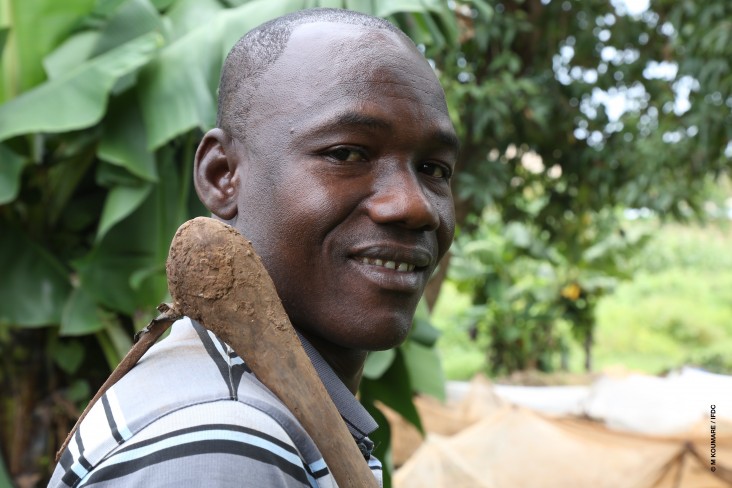Speeches Shim

July 2018 — The saying “land does not deceive anyone” has become the motto of Alassane Berthe, a farmer who works on the lush green landscape in Sanoubougou village located in Mali’s southern region of Sikasso. While many young people in the region are tempted by urban migration, or work in traditional gold mining sites where they risk their lives, Berthe decided to stay with his family and invest in the land.
In 2016, Berthe received training and support from USAID through the Feed the Future Scaling up Fertilizer Deep Placement and Micro Dosing Technologies in Mali project, which is implemented by the International Fertilizer Development Center.
As a result, he is now considered a resource on the use of the two fertilizer technologies that have reduced production costs by one-third and doubled crop yields.
“Since I started using these agriculture technologies, my production’s costs decreased, while my crops increased significantly. People come to buy my okra directly from my farm. Today I don’t envy civil servant workers as I have good income,” said Berthe, who is 40 years old.
Fertilizer deep placement consists of placing fertilizer briquettes into the soil, near the plant’s root zone, which provides the plant with nutrition throughout its growth cycle. This method allows rice and vegetable producers to increase their production and incomes.
Micro dosing consists of applying very small, affordable amounts of fertilizer directly to plant roots. This method increases fertilizer efficiency and can double the productivity of millet and sorghum crops.
For the last three years, the International Fertilizer Development Center trained Malian farmers, including Berthe, in the effective use of the technologies. From 2015 to 2017, the fertilizer deep placement and micro dose methods increased the production of rice, millet and sorghum for more than 300,000 farmers — 63,000 of whom were women farmers — from Sikasso, Ségou, Mopti and Timbuktu regions. Additionally, more than 3,700 producers, including 2,530 women, involved in market gardening started using fertilizer deep placement for okra, eggplant, amaranth, tomato, pepper and onion production.
In his 4,200-square meter plot, Berthe harvested 8,900 kilograms of okra in 2017. He consumed 270 kilograms and sold the surplus, making a profit of $1,400 — a 30 percent increase in income over what he earned when he previously grew parsley.
Fertilizer deep placement and micro dosing are also contributing to improved ecosystems and nutrition. Excessive use of fertilizers causes pollution of run-off and groundwater. Because the new methods reduce the amount of fertilizer used, they also reduce nitrate levels in groundwater and surface water. And the increased production of vegetables in the area impacts the nutritional quality of producers’ households as well as other households in the community.
Today, many small-scale producers from Berthe’s region are inspired by his success, and are now able to increase their income without spoiling the environment by using the new technologies.
“To my fellow farmers, I answer that the use of fertilizer technologies contributed substantially to my success today,” said Berthe. “Moreover, with this technology, our market gardening products contribute to improve the nutrition status of our households.”
The USAID fertilizer project runs from April 2014 to April 2019.
LINKS
Follow @USAIDMali, on Facebook

Comment
Make a general inquiry or suggest an improvement.